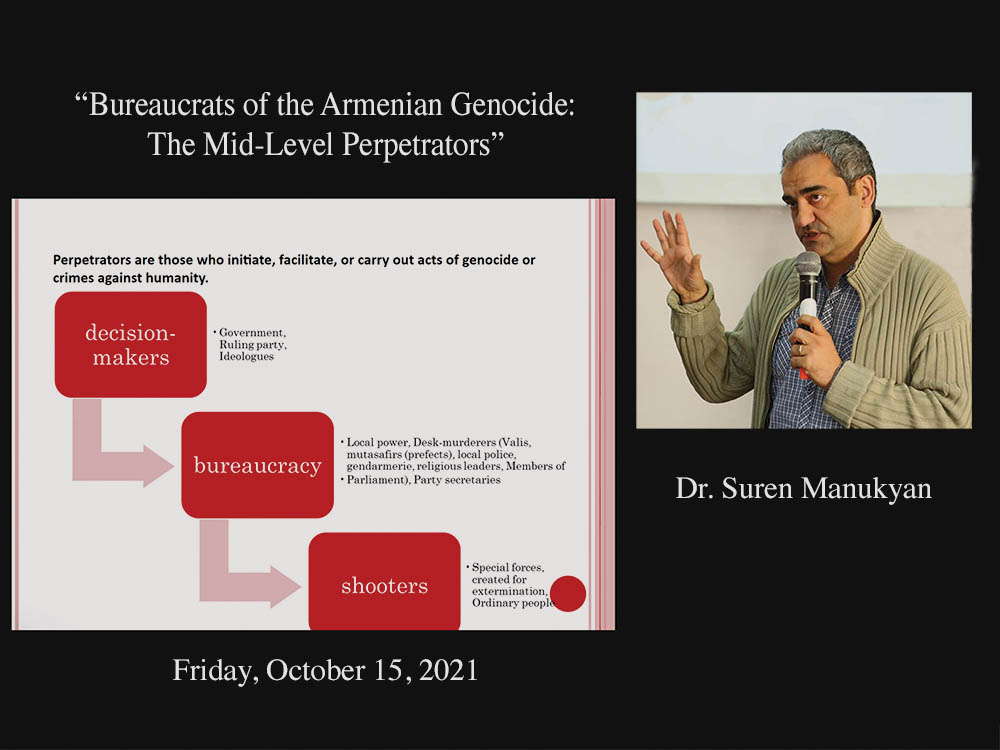
Michael Mazman
Staff Writer
On Friday, October 15, 2021, the Armenian Studies Program hosted Dr. Suren Manukyan for the second installment of his three-part lecture series on the perpetrators of the Armenian Genocide, titled “Bureaucrats of the Armenian Genocide: The Mid-Level Perpetrators.”
Similarly to his first presentation, “Architects of the Armenian Genocide,” Dr. Manukyan began his presentation by discussing the hierarchy of perpetrators involved in the Armenian Genocide, which consists of government decision makers, local public officials, and ordinary private individuals. This presentation was primarily focused on the mid-level perpetrators – local Ottoman bureaucrats, who were directly involved in regulating and perpetrating the Armenian Genocide under the orders of top government authorities.
Dr. Manukyan introduce some of the Ottoman bureaucrats that were most notable for their active involvement in the perpetuation of the Armenian Genocide: Cevdet Bey, the vali (governor) of Van, who personally led the executions of Armenians in his jurisdiction and Cemal Azmi, the vali of Trebizond, who was famous for his cruelty. “Nightly discussions were held at the headquarters of the Committee of Union and Progress about torture techniques,” stated Dr. Manukyan. “Each new method of inflicting pain was hailed as a splendid discovery… and Cemal Azmi was the champion of proposing these new methods of torture.”
Dr. Mehmed Reshid, the vali of Diyarbekir, was another infamous local official who personally participated in the murders of countless Armenians. Being a medical doctor, Mehmed Rashid justified his cruelty towards the Ottoman Armenians by comparing them to “hazardous microbes” in the body of his country, stating that it was his duty to kill “microbes.” In fact, many of the Young Turk government officials were physicians, so the use of this medical terminology (i.e. microbes, cancers, tumors, etc.) was very common in a constant effort to dehumanize the Armenian population.
Although these provincial governors played an instrumental role in leading the Ottoman Empire to plan and commit genocide, they accomplished this task with the help of other like-minded bureaucrats such as the heads of the gendarmerie, local police, mutasarifs (district heads), religious leaders, and even members of the Ottoman parliament. In 1913, the Committee of Union and Progress carefully selected and appointed party agents to form clubs with these bureaucrats that would serve as a form of regional governmental authority.
Once these clubs were established, they took over the role of facilitating the Armenian Genocide by becoming the link between the high-ranking Ottoman government officials and ordinary Ottoman citizens.
The bureaucrats fulfilled this role through their control over the Ottoman Empire’s means of communication, such as the telegraphs and the railways. With full control of these tools, they were able to convey the directives of the Committee of Union and Progress to the public – often personally participating in deportations, killings, and lootings in an effort to lead the masses by example.
“On the local level, these party agents were licensed for total control with a purpose of ensuring the proper process of the Genocide,” stated Dr. Manukyan. “[The Young Turks] needed people that they knew were committed enough to take orders from above without relenting or hesitating.”
Most of the appointed party agents were former military officers, so they were capable of leading their local clubs with strict efficiency. The killings and seizure of Armenian property were often carried out through paramilitary violence. “They would circle Armenian settlements, break into the homes, and forcibly detain the population for deportation,” explained Dr. Manukyan.
The Armenians that were not killed on sight were mostly forced to participate in death marches, which were supervised by the gendarmerie. They were driven through the desert, where they would be deprived of rest, prohibited from eating or drinking, expropriated of their clothes/jewelry, raped, and tortured until they eventually perished.
Cruel and unusual punishment such as the death marches were not uncommon among the acts of genocide perpetuated by the Ottoman bureaucrats. Unfortunately, any effort to de legitimize the existence of the Armenian population was praised and encouraged by the top-level decision makers at the Committee of Union and Progress.
Henry Morgenthau, the Ambassador of the United States in the Ottoman Empire from 1913-1916, is famously quoted in his book titled The Murder of a Nation, “Up to that time most of them had been combatants, but now they were all stripped of their arms and transformed into workmen. Instead of serving their country as artillerymen and cavalrymen, these former soldiers now discovered that they had been transformed into road laborers and pack animals.”
Surely, a project as large-scale as the Armenian Genocide would not have been possible without the involvement and approval of its mid-level perpetrators, the Ottoman bureaucrats. Their contribution to spreading the Young Turk’s hateful regime played an essential role in encouraging the Ottoman population to rise up against the Armenians.
At the conclusion of the lecture, Dr. Manukyan gave his closing remarks and moderator Prof. Barlow Der Mugrdechian facilitated the question-and-answer portion of the discussion.
 Hye Sharzhoom Armenian Action
Hye Sharzhoom Armenian Action